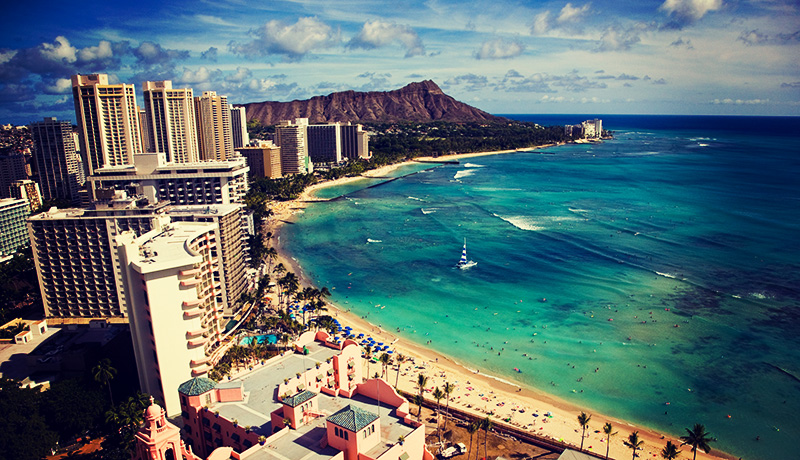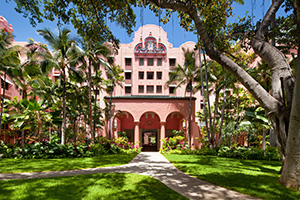
“Hawaii is one of the most unique places in all of the world,” says Fred Hemmings, renowned surfer, former Hawaii senator and overall beloved Oahu figure.
Over a towering slice of hula pie at Duke’s Waikiki, the Honolulu native makes his case. “We are born from the ocean,” he says, pointing out the islands’ unique geography. “It’s one of the last places on earth to be settled because of the isolation. There’s very rapid change, but our culture has endured.”
That enduring culture sets Oahu apart from any other U.S. destination. Obviously, the tropical landscape is vastly different. But it goes beyond that — the people are different (there’s no ethnic majority), the food is different (a diverse state makes for a fusion of global culinary influences) and the laidback, friendly “aloha” vibe is different.
We’d never suggest visiting Oahu without spending time on the beach, but tourists sometimes get so dazzled by the soft sand that they don’t explore the other rich facets of the island. Here are some ways that you can soak up some Oahu culture from beyond your beach towel.
The Water
In Oahu, surfing isn’t merely a hobby; it’s a way of life. Early every morning, locals pound waves on the empty beaches before heading to work. It’s part of their routine.
While it’s hard to pinpoint who originated surfing — reports of the first surfers date back to 1777 with the Tahitians — Hemmings says that the pioneers were closer to home. “Hawaiians invented the sophisticated art of riding waves.”
Hemmings should know. One of his closest friends was Duke Kahanamoku, an Olympic Gold medalist and the father of modern surfing. In 1911, the 21-year-old Kahanamoku entered his first swimming competition and broke three freestyle records. He is credited with spreading surfing’s popularity throughout the mainland and the world, and was the first inductee into the both the surfing and the swimming halls of fame.
Kahanamoku has been immortalized with a bronze statue on Kuhio Beach, where he fronts a surfboard, arms outstretched — often draped with leis — to welcome you to Waikiki. Learn more about him by perusing the photos that plaster the walls in Duke’s Waikiki (named after the iconic surfer, of course).
And while you can spy surfers on Waikiki at any time, check out the annual Duke’s OceanFest (set for August 20 to 28 this year) as it celebrates the legend and his favorite sports, including longboard surfing, paddleboard racing, swimming, tandem surfing, surf polo, beach volleyball and stand-up paddling. Or give it a go yourself and get a lesson from the Waikiki Beach Boys (people like Kahanamoku who teach travelers to surf or canoe) in beachside booths near the statue.
The History
Hotels fight for sand along coveted Waikiki, but The Royal Hawaiian, A Luxury Collection Resort is the most distinctive. And it’s not only because its shocking-pink Spanish-Moorish façade jumps out from the rest of the structures lining the beach.

The Royal Hawaiian, A Luxury Collection Resort, Photo Courtesy of Starwood Hotels & Resorts Worldwide Inc
The second-oldest hotel in Oahu (behind Moana Surfrider, its sister property), The Royal Hawaiian has a history that stretches back to King Kamehameha I, the famed leader who united the Hawaiian Islands. After the king conquered Oahu, he vacationed on the land where the hotel now stands. To honor this royal link, the hotel named its Kamehameha Suite after the king and adorned the master bedroom with the colors of the Hawaiian monarchy — red and yellow.
The 1927-opened hotel continued to play a key role in local history: Its Coconut Grove garden once served as the setting for Queen Kaahumanu’s summer palace, and the U.S. Navy leased the resort as a rest and recreation center for the Pacific Fleet during World War II. Delve deeper into the hotel’s past with its twice-weekly Royal Hawaiian History Tours, which are complimentary for guests.
While the hotel will celebrate its 90th anniversary in February, it is far from a relic. The Royal Hawaiian makes use of its enviable location for the backdrop of ‘Aha‘aina, Waikiki’s only waterfront luau — of course, luaus and their hula shows are cultural musts in Hawaii.
In 2015, it debuted a renovated Mailani Tower, a more modern and exclusive option. The tower has its own reception area, concierge and lounge that serves a free light breakfast and evening snacks, cocktails, wine and more for Mailani guests. Rooms come with vivid paintings from local artists Solomon Enos and Carl Pao, aromatic Malie Organics toiletries from Kauai that you’ll want to pilfer and many have pool and/or ocean views.
Venture outside of the hotel to discover more of Oahu’s history. As the only royal palace in the U.S., Iolani is a popular stop-off. The 1882 structure was groundbreaking for its time — it was fully electrified before the White House and had a telephone only a few years after its invention.
Inside, stroll through the ruby-and-gold-filled Throne Room, where King Kalakaua would throw lavish parties, and the Gold Room, where the royal family would play and listen to music. Pop into the Basement Galleries to see historic photos and a collection of crown jewels, including a gold-mounted boar’s tusk pin and a diamond butterfly brooch with fluttering wings.
A visit to the Bishop Museum should top your list. The museum recently procured its biggest find: an ‘ahu ‘ula (feathered cloak) and a mahiole (feathered helmet) from Kalani’opu’u, the chief of Hawaii Island, that were gifted to captain James Cook upon his 1779 arrival in Kealakekua Bay. This is the first time both artifacts have returned together since they left on Cook’s ship 237 years ago. When the exhibit opened in March 2016, it drew the largest turnout the museum had ever seen, according to a Bishop official. The treasures are impressively intact, and the cloak, in particular, is a showstopper woven with red and yellow feathers plucked from 20,000 birds.
The Land
Oahu’s 597 square miles are rife with culture. About 3,000 feet above the island’s coastline, Nuuanu Pali draws visitors with panoramas of the Koolau cliffs and the Windward Coast. But it’s not merely a scenic lookout: Nuuanu Pali was the site of the Battle of Nuuanu, where in 1795 King Kamehameha I defeated the local chief and added Oahu to his kingdom, thus beginning the islands’ reunification. During the fierce battle, hundreds of soldiers were forced off of the rocky cliffs to their deaths.
Some spots veer off of the usual tourist paths. The Ulupo Heiau, for example, could easily be overlooked, as the state historic site holds a massive amount of dismantled rocks. It was a sacred temple built by the menehunes — mythical Polynesian dwarves who work at night as stone builders — to worship the Hawaiian gods.
Ten miles from the Ulupo Heiau, 4,000-acre Kualoa Ranch nature preserve captivates with its beauty. Stand in the verdant Ka’a’awa Valley and you’ll feel awestruck surrounded by rugged mountains piercing the electric-blue sky and the aquamarine waters of Kaneohe Bay behind you. Ancient Hawaiians felt the same way; they considered Kualoa to be one of the most sacred places on Oahu. Kualoa served as the residence of kings and a puʻuhonua, or a training ground where royalty learned the art of war and history.
The ranch was purchased in 1850 from King Kamehameha III and is still run by the same family. The sixth-generation owners also use it as a cattle ranch and as a farm, as they harvest oysters and grow guava, star fruit and more.
Another great thing about visiting Kualoa is that you can explore it in a multitude of ways. Traverse the terrain by ATV, horseback, jungle vehicle, catamaran or zipline tour. Our pick is the brand-new Premier Movie Sites Tour. Since 1950, Kualoa’s exquisite landscape has starred in a slew of films and TV shows, and this tour takes you behind the scenes. You’ll drop by Jurassic World’s Indominus Rex dinosaur pen, Lost’s bunkers, a Hawaii Five-0 set and 50 First Dates’ Hukilau Cafe.
Foodies will want to opt for the new Taste of Kualoa, a farm-to-table tasting tour that sends you to the shrimp and tilapia ponds, oyster farm, tropical fruit gardens and the grazing grounds of the grass-fed cattle for bites.
[The Music
For tourists, ukuleles conjure up images of a clichéd Hawaiian souvenir stocked in all of the ABC stores and airport shops. But that’s because you’ve never heard Jake Shimabukuro play his stirring rendition of “Ave Maria.” The Honolulu native has been hailed as the Jimi Hendrix of the ukulele. He has collaborated with a host of well-known artists, including Yo-Yo Ma, Jimmy Buffett, Bette Midler and Ziggy Marley, and also tours the world.
“Hawaiian culture has always been built around the idea that we are all ‘ohana [family],” Shimabukuro says. “The ukulele is a simple instrument and you don’t feel like you have to be a musician to play it. The ukulele is everyone’s instrument, and when we learn to strum our first chord, we quickly realize that we are all the same. We are all one big ‘ohana.”
The ukulele has a long history in Oahu. Many students learn how to play in grade school, where it is an elective. And one of the foremost ukulele producers resides in an unassuming storefront in the Kakaʻako neighborhood. Kamaka Ukulele, a family-owned and -operated factory and shop, celebrates its 100th anniversary this year. These aren’t those tchotchkes mentioned above, though the shop did invent the original pineapple-shaped version. Handcrafted Kamaka ukuleles can cost upwards of more than $2,000 and each one has to be checked by a Kamaka family member before being shipped or sold.
If you drop by the store and Fred Kamaka Sr. is manning the counter, let the charismatic, witty patriarch regale you with stories of his family’s business. Call ahead and you can arrange for a private tour of the small factory. You never know who will show up there: During our visit, not only did we see Shimabukuro (he’s close with the family) but we ran into well-known player Herb Ohta Jr. It’s a chance encounter that only happens in Oahu.
